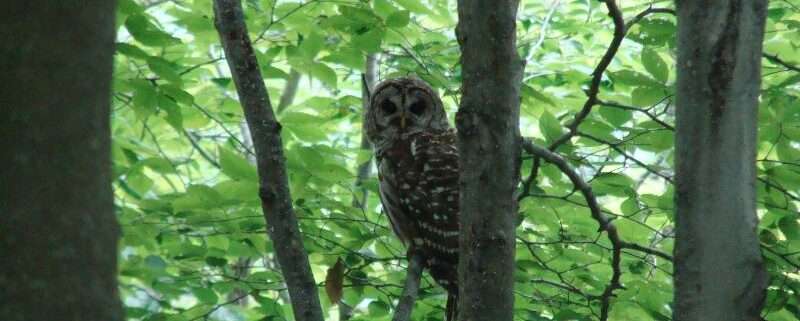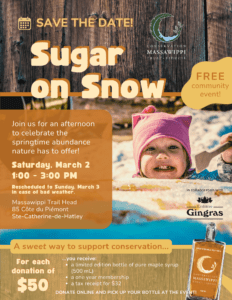For the Birds

Barred Owl: photo taken by Mahicans Diamond on the Massawippi Conservation Trust’s land.
Whether you live in the city or the countryside, birds are a part of our daily lives. They are the number one wild animal we encounter almost daily and are an early indicator of the health of the planet.
We may not even think of birds as wild animals as they are so woven into our lives. Birds are part of our common expressions: like a duck to water; take flight; the early bird catches the worm; free as a bird; an albatross around the neck; dead as a dodo; graceful as a swan; as scarce as hen’s teeth; canary in a coal mine.
Birding (or bird watching) brings us into nature, whether it is in our backyard or out at a designated observation site. Birders spend on average 133 days per year in pursuit of their passion. Gardeners, on the other hand, spend approximately 70 days per year.1 It is one of the fastest growing hobbies and the pandemic has only helped the numbers soar. One in five Canadians are enjoying this activity.
Birding took off in the late 19th century.
So much has been written about birds, birding and our relationship to each other. Did you know that there is a very interesting link between women, environmental and labour history and birds and conservation? Birds were so numerous back then that their numbers seemed inexhaustible. Billions of Passenger Pigeons and shore birds were served at the table. Victorian women, who were relatively limited in their power, published their bird observations in diaries and magazines. The growth of bird watching and botanizing promoted a new awareness and appreciation for our winged friends.
The fashion industry decimated ducks, herons and egrets for the vogue of plumed hats. An egret feather taken from the head of the bird cost more than gold. In 1896 the Massachusetts Audubon Society was established by Harriet Hemenway and Minna B. Hall. They helped to turn the tide by creating a better public awareness of birds.2,3

The decline in the bird population continued at a fast pace until the Passenger Pigeon became extinct in c 1914 and other birds became more rare. Around this time a conservation movement was born (should we say hatched?). The first international wildlife treaty was signed in August 1916 called the Canadian-United States Migratory Birds Convention. Soon after came the Canadian Migratory Birds Convention Act.4 The American Migratory Bird Treaty Act of 1918 followed and is still today the strongest legislation for the protection of birds in the United States. Since birds migrate from Northern Canada to the Gulf of Mexico this cross border collaboration was essential to their survival.
Birding can be quite simple.
You can do it in your backyard or at the park using your naked eyes to observe. A pair of binoculars can be a great help. The ABC’s of birding start with looking for birds and observing their movements by locking your eyes onto them. Identifying the birds takes a bit of practise. You look at the bird’s size, shape, colour, observe its behaviour, song and habitat. These are the main factors which help you to identify a bird. You can learn about the main bird groups: waterfowl sauvagine (Mallard Duck) colvert ; hawks and falcons (American Kestrel) crécerelle d’Amérique; shorebirds (Sandpiper) and gulls (Ring-billed Gull); and perching birds (Black Capped Chickadee) and tree clinging birds (Woodpecker). Choose a field guide in book form or with an APP to identify the bird by name.
The Audubon Society, eBird Canada and Merlin Bird ID are all good APP’s with easy to use identification tools which can be tailored to your region. Quebec has close to 400 varieties of birds and identifying them can be a fun challenge.
Another way to learn is to join a friend or a birding group. Locally we have the Société de loisir ornithologique de l’Estrie (SLOE) brings together people interested in bird watching in their natural environment and ensures the development and practice of birding in the Eastern Townships. You can become a member for $20 per year and join them for virtual and physical activities. They will be birding on May 15th in Scowen Park. One of their members, Bernard Jolicoeur, hosted a very informative radio series in French on Radio Canada, the links to which are on the SLOE website.
April and May are wonderful months to observe birds. Spring is signaled by the arrival of the American Robin and other birds whose songs fill the air. You can learn to identify their calls by using the APPs mentioned earlier.
The GrandDéfi Québec Oiseaux5 takes place throughout the month of May. Inaugurated in 2011, the Grand Défi QuébecOiseaux aims to raise awareness and funds for the protection of birds in Quebec. The event takes the form of a 24-hour birding marathon during which participants must observe as many species of birds as possible from a fixed point or on the move, on any day in May.
Saturday May 8th is World Migratory Day. You can host an event via birdday.ca website in conjunction with Nature Canada, QuébecOiseaux and Environment for the Americas. Their call to action:
We urge you to participate in our Discover Migratory Birds activities and download resources to help you uncover, cultivate, and celebrate your inner birder.6
Do you need more inspiration to become a birder or if you enjoy inspirational nature photography the Audubon Society has a list of interesting birders on Instagram.
State of Canada’s Birds was published in 2019 by the National American Birds Conservation Initiative. It is an easy to read report which is well worth taking your time to do so.
‘’The North American Bird Conservation Initiative (NABCI) in Canada is a coalition of federal, territorial and provincial governments, non-government and industry organizations, working in partnership with the United States and Mexico to protect, restore, and enhance North American bird species and their habitats. NABCI-Canada’s goal is to deliver the full spectrum of bird conservation in Canada, through regionally-based, biologically-driven, landscape-oriented partnerships.’’7
The press release for the publication said:
“Several bird groups have experienced significant declines. Canada has lost 40% to 60% of shorebird, grassland bird and aerial insectivore populations. These groups make up 80% of all bird species that were newly assessed as threatened or endangered in Canada over the last decade. The loss of important lands and waters, unsustainable agricultural practices, climate change and pollution are the most important causes of these declines. These threats affect birds on their Canadian breeding grounds, during their migration and on their wintering grounds, highlighting the need for strong international conservation action.
Over the same period, other species have benefited from investments in conservation by government, non-government and industry organizations. Geese and duck populations have increased by 360% and 150%, respectively, since 1970. Some goose species have also taken advantage of increased waste grain in agricultural areas and are now so abundant that there is concern about the potential impacts of these birds on other species. Populations of birds of prey have increased by 110% thanks to the ban on the indiscriminate use of DDT. When we understand the problem and take action together, conservation works.”8

One in three Canadian birds depends on forests. The Massawippi Conservation Trust hopes to ensure the survival and protection of bird life on our territory by protecting pristine forests and the watershed of Lake Massawippi. In one day alone, the biologists from Appalachian Corridor identified almost 30 different species among those spotted during a one day inventory. Five priority species were seen that are of particular interest due to diminishing populations in the province and beyond. They are the white-throated Sparrow, the black- throated Green Warbler, the black-throated Blue Warbler, the Yellow-bellied Sapsucker and the Eastern Wood Pewee. These would most likely be seen along the entire ridge.
What can we as individuals do to help birds survive and thrive?
- Learn about birds
- Buy Bird-Friendly
- Support conservation
- Keep cats indoors
- Welcome birds home by planting native vegetation
- Prevent collisions
- Build Nesting Boxes
Learn more, the sky’s the limit!
You don’t need to go far to find talented birding photographers. A neighbour has a bird feeder in his backyard and often posts the most captivating photos of local birds.
Here are some of Marc Théberge’s images.

Eastern Towhee (Tohi à flancs roux) © Marc Théberge

Female Cardinal (Cardinal, femelle) © Marc Théberge

Yellow-bellied Sapsucker (Pic maculé) © Linda Huffman

Yellow Bellied Flycatcher (Moucherolle à ventre jaune) © Marc Théberge
References:
1. The “Bird Bills”: A Tale of the Plume Boom
https://blog.newspapers.library.in.gov/the-bird-bills-a-tale-of-the-plume-boom/
2.The Victorian Women Whose Writing Popularized Watching Birds Instead of Wearing Them
https://www.ladyscience.com/victorian-women-and-birding/no48
3. Federal, Provincial, and Territorial Governments of Canada. 2014. 2012 Canadian Nature Survey: Awareness, participation, and expenditures in nature-based recreation, conservation, and subsistence activities. Ottawa, ON: Canadian Councils of Resource Ministers.
http://biodivcanada.ca/2A0569A9-77BE-4E16-B2A4-C0A64C2B9843/2012_Canadian_Nature_Survey_Report%28accessible_opt%29.pdf
4. https://www.canada.ca/en/environment-climate-change/services/birds-canada/celebrating-100-years-international-conservation/taking-birds-under-our-wings/introduction.html
5. Grand Défi QuébecOiseaux
https://quebecoiseaux.org/index.php/fr/gdqo
6. Nature Canada
https://www.birdday.ca/
7. State of Canada’s Birds
http://nabci.net/wp-content/uploads/2019-State-of-Canadas-Birds-1.pdf
8. Presse release
http://nabci.net/wp-content/uploads/EN_NR_State-of-Canadas-Birds_FINAL_2019_06_17.pdf
Other sources:
Birding hobby soars in popularity across North American
https://globalnews.ca/news/1978047/birding-hobby-soars-in-popularity-across-north-america/
Taking birds under our wings for 100 years
https://www.canada.ca/en/environment-climate-change/services/birds-canada/celebrating-100-years-international-conservation/taking-birds-under-our-wings.html
Podcast : « Ornithologie : l’ABC pour s’initier au monde des oiseaux »
https://ici.radio-canada.ca/ohdio/premiere/emissions/Ecoutez-l-estrie/segments/chronique/123863/observation-des-oiseaux-ornitologues-bernard-jolicoeur





